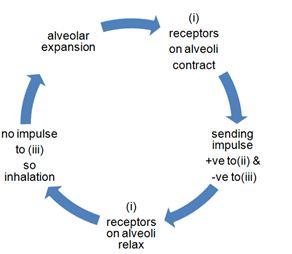Breathing and Exchange of Gases - Online Test
Q1. Which of the following is not correctly matched :
Answer : Option C
Explaination / Solution:
Respiration is a physiological process. Total lung capacity (TLC) includes vital capacity (VC) and residual volume. Cutaneous respiration is the breathing via skin.
Q2.
Read the following statements :
i. Every 100 ml of deoxygenated blood delivers about 4 ml of to the alveoli.
ii. 30% - 40% of is transported to the alveoli as carbamino-haemoglobin.
iii. At respiratory surface diffuses from venous blood into alveolar spaces.
Answer : Option A
Explaination / Solution:
20 – 25% of is transported to the alveoli as carbamino-haemoglobin.
Q3. The condition favourable for dissociation of oxygen from oxyhaemoglobin in the tissues is
Answer : Option A
Explaination / Solution:
In tissues, low , high , high concentration and higher temperature exist,the conditions are favourable for dissociation of oxygen from the oxyhaemoglobin.
Q4. The solubility of carbon dioxide is
Answer : Option C
Explaination / Solution:
The solubility of carbon dioxide is 20-25 times higher than that of oxygen, the amount of carbon dioxide that can diffuse through the diffusion membrane per unit difference in partial pressure is much higher compared to that of oxygen.
Q5. The major factor which affect binding related to the partial pressure of carbon dioxide is
Answer : Option B
Explaination / Solution:
is carried by haemoglobin as carbamino-haemoglobin. This binding is related to the partial pressure of . is a major factor which could affect this binding.
Q6. 70% of carbondioxide is transported as bicarbonate by the enzyme
Answer : Option A
Explaination / Solution:
An enzyme present in red blood cells, carbonic anhydrase, aids in the conversion of carbon dioxide to carbonic acid and bicarbonate ions. When red blood cells reach the lungs, the same enzyme helps to convert the bicarbonate ions back to carbon dioxide, which we breathe out. It transportes nearly 70% of carbondioxide as bicarbonate.
Q7. The regulatory centres for respiration are located in :
Answer : Option D
Explaination / Solution:
A specialised centre present in the medulla region of the brain called respiratory rhythm centre is primarily responsible for this regulation. In the pons region of the brain called pneumotaxic centre can moderate the functions of the respiratory rhythm centre.
Q8. In CNS, regulation of respiratory rhythm during normal breathing is largely dependent upon :
Answer : Option D
Explaination / Solution:
In central nervous system, regulation of respiratory rhythm during normal breathing is dependent upon concentration of carbon dioxide gas in air.
Q9.
Name the unlabelled parts of given flow chart :
Answer : Option B
Explaination / Solution:
The flow chart of respiratory mechanism labeled as stretch, expiratory centre and inspiratory centre respiratory. It is controlled by the medulla and pons of hind brain.
Q10. The specialized centre which can reduce the inspiratory duration upon stimulation is
Answer : Option C
Explaination / Solution:
The pneumotaxic centre can moderate the functions of the respiratory rhythm centre. Neural signal from this centre can reduce the duration of inspiration and thereby alter the respiratory rate.
